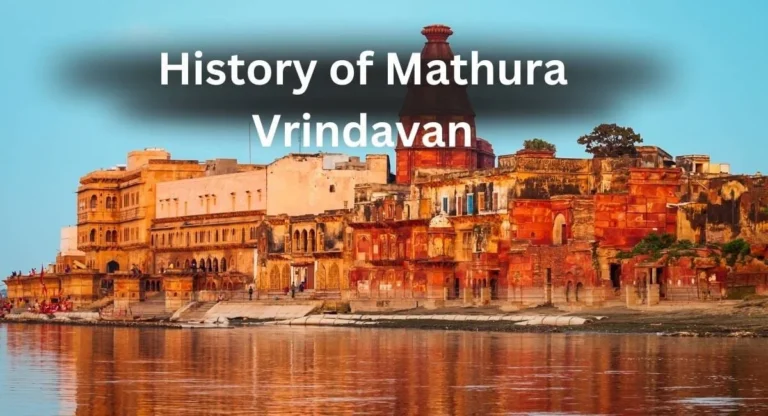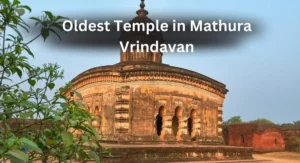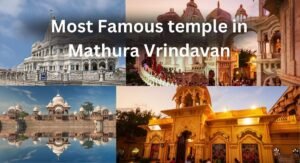Some places feel older than they look. The history of Mathura and Vrindavan is not just written in books — it’s felt in the walls, the ghats, and the trees. It lives in quiet temples, in early morning aartis, and in the songs people still sing.
Here, the past doesn’t feel like something that happened. It feels like something that’s still happening — slowly, softly, all around.
Table of Contents
ToggleMythological Background of Mathura Vrindavan – Where Legends Begin
Before cities, before roads, before maps — there were stories. And the mythological background of Mathura Vrindavan is full of them. This is the land where Lord Krishna was born, where he played, where he loved, and where he fought evil.
According to ancient texts, Mathura was ruled by Kansa, Krishna’s cruel uncle. The prison cell where Krishna was born is still visited today. People come not to see stone, but to feel what once was.
Vrindavan, nearby, was the place of his childhood. The groves, the Yamuna river, the banks where Radha and Krishna met — they all carry pieces of stories. And somehow, even after thousands of years, those stories still echo in the trees and the wind.
Krishna’s Life Events in Mathura and Vrindavan – Leela in Every Lane
You don’t need a guidebook to trace Krishna’s life events in Mathura and Vrindavan. The city itself is the book.
From the killing of Kansa to the lifting of Govardhan Hill, from his playful dances with the gopis to his flute songs under the Kadamba trees — every part of Krishna’s story has touched the soil here.
People visit Nidhivan not just to walk through it, but to wonder. Locals still believe Krishna visits this sacred grove each night. That’s why the gates close before sunset. There is faith in the unseen.
Govind Dev Ji, Banke Bihari, Radha Vallabh — every temple tells a part of the story. Every darshan feels like a page being turned.
Ancient Heritage of Braj Region – The Living Past
The ancient heritage of Braj region is more than its temples. It’s in the ghats, the markets, the bells, and even the silence. Braj is not just a place. It’s an emotion held by time.
The temples here are centuries old. Some are grand, with arches and towers. Others are small, hidden behind narrow alleys. But all of them are still alive — with prayers, with footsteps, with flowers offered each morning.
The architecture shows simplicity. Red sandstone. White domes. Carved doors. Each stone tells a story — not just of gods, but of the people who believed in them.
The History of Mathura and Vrindavan – Not Just Dates, But Feelings
We often ask for dates. Years. Timelines. But the history of Mathura and Vrindavan cannot be limited to that. Because it is not just about what happened. It is about what continues.
The temples here were built, destroyed, and rebuilt. Empires came and went. But the bhajans never stopped. The Yamuna kept flowing. The bells kept ringing.
Even now, in the early hours, you’ll hear a shankh. You’ll see a sadhu walk by. And you’ll realize — history here doesn’t sleep. It wakes up every morning with the city.
Why the Past Still Matters Today
The people who live here don’t treat these places as old. They treat them as alive. Every evening aarti is not just tradition. It is connection.
Tourists come to see. But devotees come to feel. And what they carry back is not just memory, but peace.
That’s why, at Mathura Vrindavan Temples, we say: if you walk these lanes with an open heart, the history of Mathura and Vrindavan will whisper its stories to you.
FAQs – The History of Mathura and Vrindavan
Q1. What is the mythological background of Mathura Vrindavan?
Mathura and Vrindavan are central to Lord Krishna’s life. Mathura is his birthplace, and Vrindavan is where he spent his childhood performing divine leelas.
Q2. Which life events of Krishna happened in Mathura and Vrindavan?
Krishna’s birth, childhood plays, killing of Kansa, lifting of Govardhan Hill, and his divine love with Radha all took place in this region.
Q3. What are some ancient Krishna temples in this area?
Govind Dev Ji, Radha Raman, Banke Bihari, and ISKCON temples are among the most visited ancient temples here.
Q4. Why is the Braj region historically important?
The ancient heritage of Braj region connects to thousands of years of devotional history, architecture, and living spiritual traditions.
Q5. How old is the history of Mathura and Vrindavan?
The history dates back to over 5,000 years, with references found in ancient scriptures like the Mahabharata and the Puranas.
Q6. Is it possible to explore all historical temples in one trip?
You can visit the main temples in 2–3 days, but to fully absorb the history of Mathura and Vrindavan, multiple visits are ideal.
Pack your bags, immerse yourself in the divine aura, and let the spiritual energy of Mathura Vrindavan Temples uplift your soul!
Plan Your Spiritual Journey Today
Have questions or need assistance organizing your visit to the sacred temples of Mathura and Vrindavan? We’re here to help you every step of the way.
Email us at info@mathuravrindavantemples.com
Call or WhatsApp us at +91-7819818361
Let the divine journey begin with Mathura Vrindavan Temples .




